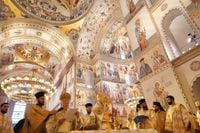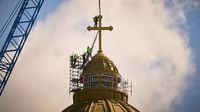On October 26, 2025, Bucharest witnessed a momentous occasion as thousands of Romanians gathered for the consecration of the iconography inside the People’s Salvation Cathedral, now officially recognized as the world’s largest Christian Orthodox church. The event was not only a spiritual milestone but also a symbol of national pride and a testament to the country’s enduring faith, which has survived wars, political upheaval, and decades of religious suppression.
The grandeur of the People’s Salvation Cathedral—also known as the National Cathedral—cannot be overstated. Towering at 134 meters (440 feet) and dominating Bucharest’s skyline, it has become visible from every approach to the city. According to Greek Reporter, the cathedral is now the tallest and largest Eastern Orthodox church by both volume and area worldwide, and the third tallest domed church globally, only surpassed by the Basilica of Our Lady of Peace in Yamoussoukro, Ivory Coast, and St. Peter’s Basilica in Vatican City. Its inner sanctuary can accommodate up to 5,000 worshippers, underscoring its monumental scale.
The consecration ceremony was attended by some of the most prominent figures in both the religious and political spheres. Ecumenical Patriarch Bartholomew I and Patriarch Daniel of Romania led the service, joined by President Nicusor Dan and Prime Minister Ilie Bolojan. Traffic was restricted around the cathedral, and giant TV screens were set up outside to allow the overflow of worshippers a chance to witness the historic event. For many, this was more than just a religious ceremony—it was a celebration of Romania’s spiritual and cultural heritage.
The cathedral’s interior is a marvel in itself. The newly consecrated iconography, which includes an astonishing 25,000 square meters of mosaics and frescoes, now holds the record for the largest collection of church mosaics in the world. The iconostasis—an ornate wall of icons and religious paintings separating the nave from the sanctuary—stretches 23.8 meters long and rises 17.1 meters high, making it the largest of its kind in Orthodox Christianity. Daniel Codrescu, one of the principal artists behind the project, told The Associated Press, “It was a complex collaboration with the church, with art historians, with artists, also our friends of contemporary art. I hope (the church) is going to have a very important impact on society because … it’s a public space.”
For the Romanian Orthodox Church, the cathedral is much more than a building. It is, as the Church has described, “a symbol of national identity.” The project’s dedication to the Ascension of Christ and Saint Andrew the Apostle—Romania’s patron saint—underscores its spiritual significance. Sunday’s celebration coincided with two other important milestones: the centenary of the Romanian Patriarchate and the 140th anniversary of the Church of Romania’s autocephaly, marking the institution’s independence from external ecclesiastical authority.
The journey to this day was anything but straightforward. The idea of constructing a national cathedral first emerged in the aftermath of the Romanian War of Independence in 1877–1878. Yet, as Greek Reporter notes, a lack of consensus, the ravages of two world wars, and the iron grip of communist rule all conspired to delay the project’s realization. It wasn’t until 1999 that discussions resumed in earnest, and the cornerstone was finally sanctified on November 29, 2007, by Patriarch Daniel. Official construction began on December 15, 2010, and the altar was consecrated in 2018. The project’s completion—at least in its current phase—was timed to coincide with these significant anniversaries, lending the event even greater historical weight.
The cathedral’s location behind the Palace of the People, itself a colossal relic of Nicolae Ceausescu’s communist regime, is rich in symbolism. Where once the state sought to suppress religion, now stands a beacon of faith and resilience. According to the Associated Press, Romania is among the most pious countries in the European Union, with about 85% of its 19 million citizens identifying as religious. For many, the cathedral’s rise is a vindication of their enduring beliefs.
Yet, the project has not been without controversy. The cost, by any measure, is staggering. Estimates vary between 200 million euros ($216 million) and 270 million euros ($313 million), with the bulk of funding coming from public coffers and the remainder from private donations. The cathedral’s website states that some works remain unfinished, and the debate over its price tag continues to simmer in Romanian society.
Critics argue that the funds could have been better spent addressing Romania’s pressing needs in education and healthcare. Claudiu Tufis, an associate professor of political science at the University of Bucharest, did not mince words: “The fact that they have forced, year after year, politicians to pay for it, in some cases taking money from communities that really needed that money, indicates it was a show of force, not one of humility and love of God,” he told the Associated Press. Still, he acknowledged that the cathedral could offer “a boost to national pride and identity” and might prove economically beneficial as a tourist attraction in the long run.
Others, like Rares Ghiorghies, a 37-year-old supporter of the church, see the value in the project but question the priorities behind such massive spending: “The big problem in society is that most of those who criticize do not follow the activities of the church. But the money would be better spent on health and education as a matter of good governance.”
For the faithful, however, the cathedral’s completion is a source of deep joy and spiritual fulfillment. Ecumenical Patriarch Bartholomew I, addressing the congregation, emphasized the transcendental power of religious art: “The holy Icons, both the portable ones and those depicted on the walls of the Churches, are carriers of divine grace, which is why we have such numerous miraculous icons. They connect the present with eternity, they raise us from the mundane of everyday life to the high and holy, they bring God close to man.”
As the sun set over Bucharest on October 26, the People’s Salvation Cathedral stood as a testament to Romania’s complex history, its enduring faith, and the sometimes uneasy intersection of spiritual aspiration and public responsibility. Whether it’s seen as a triumph of national identity, a controversial use of public funds, or a future magnet for pilgrims and tourists, there’s no denying the cathedral’s place in the heart—and skyline—of Romania.

